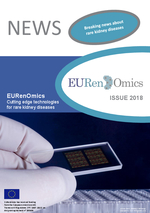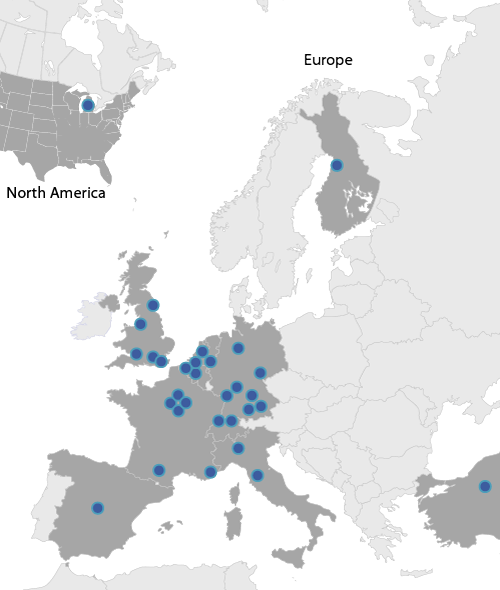EURenOmics Project Executive Summary Years 1 to 5
Rare kidney diseases impact markedly on life expectancy and quality of life. At the outset of this project, disease understanding and clinical management were compromised by a limited physiopathological knowledge base, low rates of diagnostic ascertainment, the absence of biomarkers predicting the risk and rate of disease progression, and a lack of effective therapies and disease models suitable for therapeutic research.
EURenOmics focused on steroid-resistant nephrotic syndrome (SRNS), membranous nephropathy (MN), hereditary tubulopathies, complement disorders, and malformations of the kidney and urinary tract (CAKUT). The consortium had access to >15,000 well phenotyped patients with >10,000 DNA, >3,000 serum, 2,000 urine, 500 amniotic fluid and 3,000 kidney biopsy specimens, and applied a wide range of high-throughput technologies, systems biology approaches and a plethora of in vitro, ex vivo and in vivo models to study disease mechanisms and explore novel therapeutic approaches.
A ‘renal phenome’ database integrating clinical information from various registries and a kidney-focused bioinformatic analysis pipeline were established. Exome sequencing performed in 315 families led to the discovery of 37 new disease genes and genomic rearrangements. Furthermore, NGS panels capturing all known genes per disease group were developed and applied in more than 4,200 patients, establishing a genetic diagnosis in 65% of tubulopathy, 40-50% of aHUS, 20-25% of SRNS, and 6-10% of CAKUT patients. Integration of clinical databases and genetic findings allowed deep phenotyping and genotype-phenotype association studies in more than a dozen large patient cohorts with defined genetic diagnoses.
The availability of large biorepositories fostered unbiased searches for diagnostic and prognostic biomarkers. Integrative bioinformatic analysis based on tissue transcriptome information unsurfaced urinary EGF as a novel biomarker of renal failure progression, which was confirmed in adult and pediatric cohorts. Peptidomic, metabolomic and microRNA profiling of body fluids yielded promising molecular signatures discriminating disease entities in SRNS and complement diseases, as well as poor from favourable prognosis in MN and prenatal CAKUT.
Fundamental progress in the understanding of genetic disease penetrance was achieved. For the first time, combinatorial mutation-dependent pathogenicity was described in compound heterozygous NPHS2 nephropathy. Common gene variants associated with disease risk were identified in MN, aHUS, and hypomagnesemia as novel mechanisms explaining variable phenotype expression.
Major progress was also made concerning molecular mechanisms of auto-immune disease. The target epitope of autoantibodies in MN and the HLA class-II peptidome were identified, the latter paving the way for unbiased identification of immune response targets in autoimmune diseases. In aHUS CFH autoantibody formation was found to emerge from deficient B-cell regulation by CFHR3 deficiency, demonstrating a mechanistic link between genetic disease and autoimmunity.
Remarkably, our research in rare nephropathies unsurfaced clues to general risk factors for common kidney diseases; e.g., common variants in the ATKD gene UMOD predispose to chronic kidney disease and hypertension, and abnormalities in the complement gene CFHR1 affect the risk and progression of IgA nephropathy.
In the search for new therapies, drug re-purposing allowed rapid progress in several areas such as rituximab for MN, eculizumab for secondary aHUS, and CoQ10 for hereditary mitochondrial podocytopathies. Promising new molecular therapies are tested experimentally, including monoclonal complement antibodies and flavaglines in hypomagnesemia. High-throughput compound screening in novel cell and animal models has identified repurposable drugs reversing the pathogenic effects of mutations in podocytopathies and ciliopathies, and models suitable for compound screening have been established for several hereditary tubulopathies, metabolic nephropathies and complement disorders.
In conclusion, the research results of EURenOmics will impact substantially on diagnostic management, risk assignment and therapeutic approaches in patients with rare kidney diseases, with potential implications also for patients with common kidney and other diseases and the society at large.
A PDF of the final publishable summary of EURenOmics can be downloaded here.






